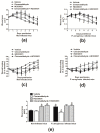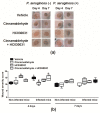Topical Application of Cinnamaldehyde Promotes Faster Healing of Skin Wounds Infected with Pseudomonas aeruginosa
- PMID: 31027179
- PMCID: PMC6515316
- DOI: 10.3390/molecules24081627
Topical Application of Cinnamaldehyde Promotes Faster Healing of Skin Wounds Infected with Pseudomonas aeruginosa
Abstract
Wound healing can be delayed following colonization and infection with the common bacterium Pseudomonas aeruginosa. While multiple therapies are used for their treatment, these are ineffective, expensive, and labour-intensive. Thus, there is an enormous unmet need for the treatment of infected wounds. Cinnamaldehyde, the major component of cinnamon oil, is well known for its antimicrobial properties. Herein, we investigated the effects of sub-inhibitory concentrations of cinnamaldehyde in the virulence of P. aeruginosa. We also assessed its healing potential in P. aeruginosa-infected mouse skin wounds and the mechanisms involved in this response. Sub-inhibitory concentrations of cinnamaldehyde reduced P. aeruginosa metabolic rate and its ability to form biofilm and to cause haemolysis. Daily topical application of cinnamaldehyde on P. aeruginosa-infected skin wounds reduced tissue bacterial load and promoted faster healing. Lower interleukin-17 (IL-17), vascular endothelial growth factor (VEGF) and nitric oxide levels were detected in cinnamaldehyde-treated wound samples. Blockage of transient receptor potential ankyrin 1, the pharmacological target of cinnamaldehyde, abrogated its healing activity and partially reversed the inhibitory actions of this compound on VEGF and IL-17 generation. We suggest that topical application of sub-inhibitory concentrations of cinnamaldehyde may represent an interesting approach to improve the healing of P. aeruginosa-infected skin wounds.
Keywords: Pseudomonas aeruginosa; cinnamaldehyde; skin wound; wound healing.
Conflict of interest statement
The authors declare no conflict of interest.
Figures






References
-
- Mihai M.M., Holban A.M., Giurcăneanu C., Popa L.G., Buzea M., Filipov M., Lazăr V., Chifiriuc M.C., Popa M.I. Identification and phenotypic characterization of the most frequent bacterial etiologies in chronic skin ulcers. Rom. J. Morphol. Embryol. 2014;55:1401–1408. - PubMed
MeSH terms
Substances
Grants and funding
- 3325/2013 finance code 001/Coordenação de Aperfeiçoamento de Pessoal de Nível Superior
- grant numbers 309046/2016-5 to E.S.F. and 305058/2018-5 to E.A./Conselho Nacional de Desenvolvimento Científico e Tecnológico
- 00740/13/Fundação de Amparo à Pesquisa e ao Desenvolvimento Científico e Tecnológico do Maranhão
- 465430/2014-7/Programa INCT-INOVAMED
LinkOut - more resources
Full Text Sources

